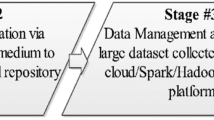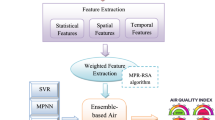Abstract
Air pollution is one of the main environmental pollution, in which air pollution component prediction is an important problem. At present, there have been many studies using machine learning methods to predict air pollution components. However, due to its numerous influencing factors and incomplete determination, there are still problems in accurate prediction. In this paper, the gas factors and meteorological factors collected by the self-developed integrated system are firstly used to construct the original feature set. Then, the mRMR algorithm is used to select data features from the perspective of maximum correlation and minimum redundancy. Finally, a prediction method of PM2.5 concentration in the next hour based on feature selection and XGBoost is designed by combining the data after dimension reduction with the XGBoost model. The experimental results show that mRMR algorithm can effectively select the features of air, and the prediction accuracy is improved even when only half of the features of the original data are used.
The work is supported in part by the State’s Key Project of Research and Development Plan under Grants (2019YFE0196400), Industry-University-Research Cooperation Project in Zhuhai (ZH22017001200072PWC), Guangdong Provincial Special Fund For Modern Agriculture Industry Technology Innovation Teams (No. 2021KJ122), and the Open Research Fund Program of Key Laboratory of Industrial Internet and Big Data, China National Light Industry, Beijing Technology and Business University.
Access this chapter
Tax calculation will be finalised at checkout
Purchases are for personal use only
Similar content being viewed by others
References
Zamani Joharestani, M., Cao, C., Ni, X., et al.: PM2.5 prediction based on random forest, XGBoost, and deep learning using multisource remote sensing data. J. Atmosphere 10(7), 373 (2019)
Iskandaryan, D., Ramos, F., Trilles, S.: Air quality prediction in smart cities using machine learning technologies based on sensor data: a review. J. Appl. Sci. 10(7), 2401 (2020)
Li, J.X., Liu, X., Liu, J., Huang, J.: Prediction of PM2.5 concentration based on MRMR-HK-SVM model. J. Chin. Environ. Sci. 39(6), 2304 (2019)
Xu, X., Ren, W.: Prediction of air pollution concentration based on mRMR and echo state network. J. Appl. Sci. 9(9), 1811 (2019)
Ma, J., Yu, Z., Qu, Y., et al.: Application of the XGBoost machine learning method in PM2.5 prediction: a case study of Shanghai. J. Aerosol Air Qual. Res. 20(1), 128–138 (2020)
Pan, B.: Application of XGBoost algorithm in hourly PM2.5 concentration prediction. In: IOP Conference Series: Earth and Environmental Science, vol. 113, no. 1, p. 012127. IOP Publishing (2018)
Benesty, J., Chen, J., Huang, Y., et al.: Pearson correlation coefficient. In: Benesty, J., Chen, J., Huang, Y. (eds.) Noise Reduction in Speech Processing, pp. 1–4. Springer, Heidelberg (2009). https://doi.org/10.1007/978-3-642-00296-0_5
Martinez, A.M., Kak, A.C.: PCA versus LDA. J. IEEE Trans. Pattern Anal. Mach. Intell. 23(2), 228–233 (2001)
Zhang, Y., Ding, C., Li, T.: Gene selection algorithm by combining reliefF and mRMR. J. BMC Genom. 9(2), 1–10 (2008)
Author information
Authors and Affiliations
Corresponding author
Editor information
Editors and Affiliations
Rights and permissions
Copyright information
© 2022 ICST Institute for Computer Sciences, Social Informatics and Telecommunications Engineering
About this paper
Cite this paper
Zhong, W., Lian, X., Gao, C., Chen, X., Tan, H. (2022). PM2.5 Concentration Prediction Based on mRMR-XGBoost Model. In: Jiang, X. (eds) Machine Learning and Intelligent Communications. MLICOM 2021. Lecture Notes of the Institute for Computer Sciences, Social Informatics and Telecommunications Engineering, vol 438. Springer, Cham. https://doi.org/10.1007/978-3-031-04409-0_30
Download citation
DOI: https://doi.org/10.1007/978-3-031-04409-0_30
Published:
Publisher Name: Springer, Cham
Print ISBN: 978-3-031-04408-3
Online ISBN: 978-3-031-04409-0
eBook Packages: Computer ScienceComputer Science (R0)




